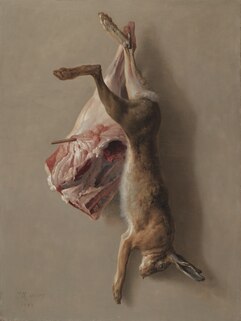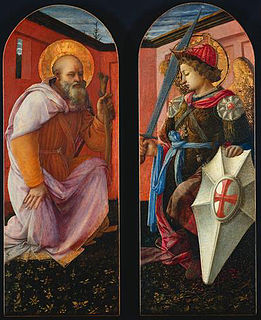 W
WThe 1472 Altarpiece was a tempera and oil on panel altarpiece by Carlo Crivelli, dated 1472 on the central panel. Also known as the Fesch Altarpiece or the Eckinson Altarpiece, it is now divided up between a number of galleries in the United States and Europe.
 W
WThe Brierwood Pipe is an oil painting of 1864 by Winslow Homer. It depicts two men from the 5th New York Volunteer Infantry.
 W
WThe Burning of the Houses of Lords and Commons is the title of two oil on canvas paintings by J. M. W. Turner, depicting the fire that broke out at the Houses of Parliament on the evening of 16 October 1834.
 W
WThe Call is a 1902 painting by Paul Gauguin, produced in Polynesia a year before the artist's death. It is now in the Cleveland Museum of Art.
 W
WThe Crucifixion of Saint Andrew (1607) is a painting by the Italian Baroque master Caravaggio. It is in the collection of the Cleveland Museum of Art, which acquired it from the Arnaiz collection in Madrid in 1976, having been taken to Spain by the Spanish Viceroy of Naples in 1610.
 W
WA Hare and a Leg of Lamb is a 1742 painting by French Rococo painter and engraver Jean-Baptiste Oudry.
 W
WThe House in Nazareth is a 1630 oil on canvas painting by Francisco de Zurbarán, now in the Cleveland Museum of Art. He also produced other variants on the same theme using a similar composition.
 W
WThe Jester Calabacillas is a 1626-1632 oil on canvas painting by Diego Velázquez, now in the Cleveland Museum of Art. Its attribution is based on stylistic similarities to other works by the artist - for example, José López-Rey sees similarities in the treatment of the face in this work and that of Bacchus in The Triumph of Bacchus. Its subject is thought to be the jester Juan Calebasse, also painted by the artist in a work now in Madrid and a now-lost work entitled "calebasses in a turban", the latter recorded in 1642 and 1655 inventories of Diego Felipez de Guzmán's collection.
 W
WLandscape with a Windmill is an early painting in oils on canvas by Jacob van Ruisdael, painted in 1646 and now in the Cleveland Museum of Art in Ohio. It had initially been loaned to them by the Mr and Mrs William H. Marlatt fund, who had bought it in 1967 from Kunsthandlung F. Kleinberger & Co, a New York art dealer, who had in turn bought it at the auction of the Cook collection at Christie's in London on 25 November 1966.
 W
WLandscape with Wheelbarrow is a watercolor created in 1883 by Vincent van Gogh.
 W
WThe Large Plane Trees is an oil painting by Vincent van Gogh. Painted in 1889 in Saint-Rémy, France, the painting depicts roadwork underneath autumn trees with yellow leaves.
 W
WLove and Psyche or Cupid and Psyche is an 1817 painting by Jacques-Louis David, now in the Cleveland Museum of Art. It shows Cupid and Psyche. It was produced during David's exile in Brussels, for the patron and collector Gian Battista Sommariva. On its first exhibition at the museum in Brussels, it surprised viewers with its realist treatment of the figure of Cupid.
 W
WMadonna and Child with Saints is a 1515 oil on panel painting by Cima da Conegliano, now in the Cleveland Museum of Art, Ohio.
 W
WPortrait of Adeline Ravoux is an oil painting from June 1890 by Vincent van Gogh.
 W
WPortrait of Agostino Barbarigo is an oil painting on canvas of 1571–72 by Paolo Veronese in the Cleveland Museum of Art, which bought it in 1928 from Italico Brass.
 W
WThe Red Cape, also sometimes known as Madame Monet or The Red Kerchief, is an oil-on-canvas snowscape by French impressionist Claude Monet. The painting depicts Claude Monet's wife, Camille, passing outside of a window dressed in a red cape.
 W
WRest is an oil painting on fabric of 1879 by William-Adolphe Bouguereau in the Cleveland Museum of Art. It depicts a young mother with her children in the shade of a tree, with the dome of St Peter's Basilica in Rome in the background. The composition recalls paintings of the Holy Family by Raphael. The work is signed at the bottom left.
 W
WSacrifice of Isaac refers to a work by Andrea del Sarto, existing in three versions at the Gemäldegalerie Alte Meister in Dresden, the Cleveland Museum of Art and the Museo del Prado.
 W
WThe Fall of Simon Magus is a late-Baroque painting by Pompeo Batoni, originally intended as the basis for a mosaic altarpiece in the Basilica of St Peter. The painting in the Cleveland Museum of Art is likely a studio copy of the original, which was displayed in the church of Santa Maria degli Angeli, Rome.
 W
WSt Anthony Abbot and Michael the Archangel are two tempera on panel works by Filippo Lippi, originally side-panels to a now lost central panel of the Madonna and Child. Produced between around 1445 and 1450, they are both now in the Cleveland Museum of Art, which also houses a later copy of the central panel by Lippi's workshop.
 W
WStag at Sharkey's is a 1909 oil painting by George Wesley Bellows depicting two boxers fighting in the private athletic club situated across from his studio. It is part of the Ashcan School movement known in particular for depicting scenes of daily life in early twentieth century New York City, often in the city's poorer neighborhoods. Participants in the boxing ring were usually members of the club, but occasionally outsiders would fight with temporary memberships. These fighters were known as "stags".
 W
WSweet Melancholy or Soft Melancholy is a painting of 1756 by Joseph-Marie Vien in the Cleveland Museum of Art.
 W
WTwilight in the Wilderness is an 1860 oil painting by American painter Frederic Edwin Church. The woodlands of the northeastern United States are shown against a setting sun that intensely colors the dramatic altocumulus clouds. Church scholar John K. Howat describes the painting as "one of his finest ever" and as "the single most impressive example of Church's depictions of unsullied North American woodlands and their most famous representation in nineteenth-century painting".
 W
WLa Vie is a 1903 oil painting by Pablo Picasso. It is widely regarded as the pinnacle of Picasso's Blue Period.
 W
WView of Florence from San Miniato is an oil on canvas painting by American artist Thomas Cole.
 W
WThe Virgin and Child with the Young Saint John the Baptist is a painting of c. 1490 by the Italian Renaissance painter Sandro Botticelli and his workshop. It is housed in the Cleveland Museum of Art.